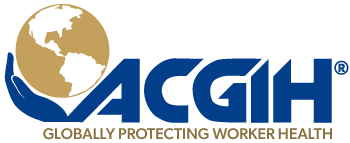- About
-
-

- About
-
ACGIH is a 501(c)(3) charitable scientific organization that advances occupational and environmental health.
-
-
- Subscriptions
-
- Science
-
-

- Science
-
This section has been established to help educate industry, government, and the public on what TLVs and BEIs are, and how TLVs and BEIs may best be used.
-
-
- Career Development
-
-

- Career Development
-
ACGIH is committed to providing its members and other occupational and environmental health professionals with the training and education they need to excel in their profession.
-
-
- Publications
-
-

- Publications
-
ACGIH has publications in many different areas that fit your needs in your field.
-
- Publications Store
- ACGIH Signature Publications
ACGIH Digital Library
If you need to purchase the Digital Library, click here.
If you have purchased and need to access the Digital Library, click here.
-
-
The American Conference of Governmental Industrial Hygienists (ACGIH®) is a private, not-for-profit, nongovernmental corporation whose members are industrial hygienists or other occupational health and safety professionals dedicated to promoting health and safety within the workplace. ACGIH is a scientific association. ACGIH is not a standards-setting body. As a scientific organization, it has established committees that review the existing published, peer-reviewed scientific literature. ACGIH publishes guidelines known as Threshold Limit Values (TLVs®) and Biological Exposure Indices (BEIs®) for use by industrial hygienists in making decisions regarding safe levels of exposure to various chemical and physical agents found in the workplace. In using these guidelines, industrial hygienists are cautioned that the TLVs and BEIs are only one of multiple factors to be considered in evaluating specific workplace situations and conditions.
Each year, ACGIH publishes its TLVs and BEIs in a book. In the introduction to the book, ACGIH states that the TLVs and BEIs are guidelines to be used by professionals trained in the practice of industrial hygiene. The TLVs and BEIs are not designed to be used as standards. Nevertheless, ACGIH is aware that in certain instances the TLVs and the BEI are used as standards by national, state, or local governments.
Governmental bodies establish public health standards based on statutory and legal frameworks that include definitions and criteria concerning the approach to be used in assessing and managing risk. In most instances, governmental bodies that set workplace health and safety standards are required to evaluate health effects, economic and technical feasibility, and the availability of acceptable methods to determine compliance.
ACGIH TLVs and BEIs are not consensus standards. Voluntary consensus standards are developed or adopted by voluntary consensus standards bodies. The consensus standards process involves canvassing the opinions, views, and positions of all interested parties and then developing a consensus position that is acceptable to these parties. While the process used to develop a TLV or BEI includes public notice and requests for all available and relevant scientific data, the TLV or BEI does not represent a consensus position that addresses all issues raised by all interested parties (e.g., issues of technical or economic feasibility). The TLVs and BEIs represent a scientific opinion based on a review of existing peer-reviewed scientific literature by committees of experts in public health and related sciences.
ACGIH TLVs and BEIs are health-based values. ACGIH TLVs and BEIs are established by committees that review existing published and peer-reviewed literature in various scientific disciplines (e.g., industrial hygiene, toxicology, occupational medicine, and epidemiology). Based on the available information, ACGIH formulates a conclusion on the level of exposure that the typical worker can experience without adverse health effects. The TLVs and BEIs represent conditions under which ACGIH believes that nearly all workers may be repeatedly exposed without adverse health effects. They are not fine lines between safe and dangerous exposures, nor are they a relative index of toxicology. The TLVs and BEIs are not quantitative estimates of risk at different exposure levels or by different routes of exposure.
Since ACGIH TLVs and BEIs are based solely on health factors, there is no consideration given to economic or technical feasibility. Regulatory agencies should not assume that it is economically or technically feasible for an industry or employer to meet TLVs or BEIs. Similarly, although there are usually valid methods to measure workplace exposures at the TLVs and BEIs, there can be instances where such reliable test methods have not yet been validated. Obviously, such a situation can create major enforcement difficulties if a TLV or BEI was adopted as a standard.
ACGIH does not believe that TLVs and BEIs should be adopted as standards without full compliance with applicable regulatory procedures, including an analysis of other factors necessary to make appropriate risk management decisions. However, ACGIH does believe that regulatory bodies should consider TLVs or BEIs as valuable input into the risk characterization process (hazard identification, dose-response relationships, and exposure assessment). Regulatory bodies should view TLVs and BEIs as an expression of scientific opinion.
ACGIH is proud of the scientists and the many members who volunteer their time to work on the TLV and BEI Committees. These experts develop written Documentation that includes an expression of scientific opinion and a description of the basis, rationale, and limitations of the conclusions reached by ACGIH. The Documentation provides a comprehensive list and analysis of all the major published peer-reviewed studies that ACGIH relied upon in formulating its scientific opinion. Regulatory agencies dealing with hazards addressed by a TLV or BEI should obtain a copy of the full written Documentation for the TLV or BEI. Any use of a TLV or BEI in a regulatory context should include a careful evaluation of the information in the written Documentation and consideration of all other factors as required by the statutes which govern the regulatory process of the governmental body involved.
- ACGIH is a not-for-profit scientific association.
- ACGIH proposes guidelines known as TLVs and BEIs for use by industrial hygienists in making decisions regarding safe levels of exposure to various hazards found in the workplace.
- ACGIH is not a standards setting body.
- Regulatory bodies should view TLVs and BEIs as an expression of scientific opinion.
- TLVs and BEIs are not consensus standards.
- ACGIH TLVs and BEIs are based solely on health factors; there is no consideration given to economic or technical feasibility. Regulatory agencies should not assume that it is economically or technically feasible to meet established TLV or BEIs.
- ACGIH believes that TLVs and BEIs should NOT be adopted as standards without an analysis of other factors necessary to make appropriate risk management decisions.
- TLVs and BEIs can provide valuable input into the risk characterization process. Regulatory agencies dealing with hazards addressed by a TLV or BEI should review the full written Documentation for the numerical TLV or BEI.
ACGIH is publishing this Statement in order to assist ACGIH members, government regulators, and industry groups in understanding the basis and limitations of the TLVs and BEIs when used in a regulatory context. This Statement was adopted by the ACGIH Board of Directors on March 1, 2002.
Enjoy exclusive benefits including free and discounted publications, conferences and continuing education courses – all while supporting the TLVs® and BEIs®.






